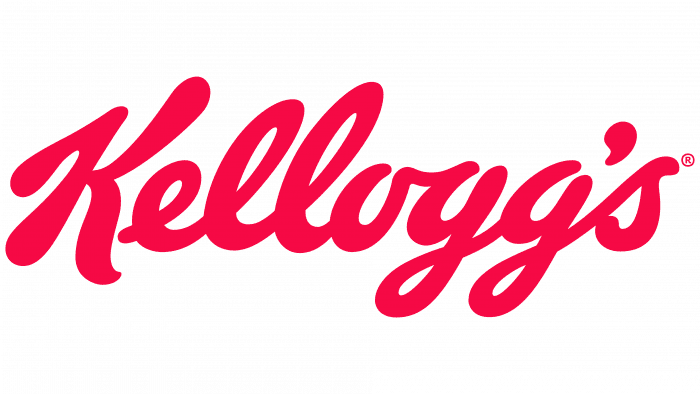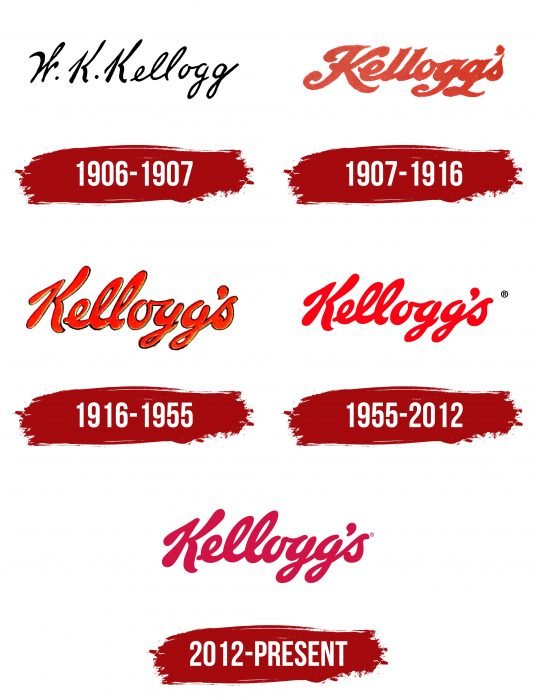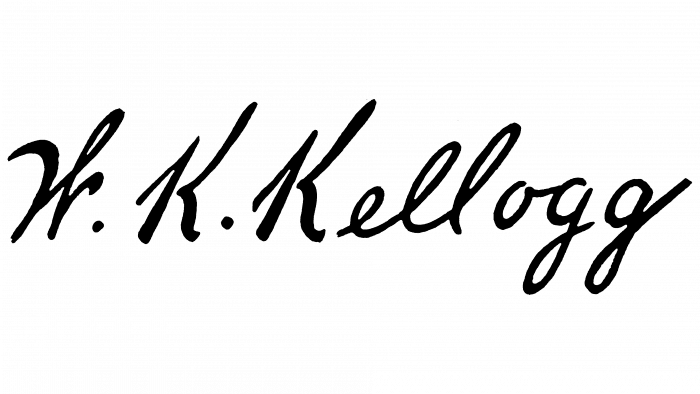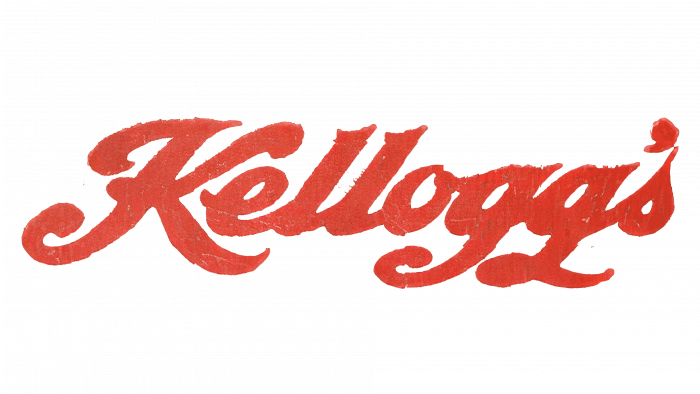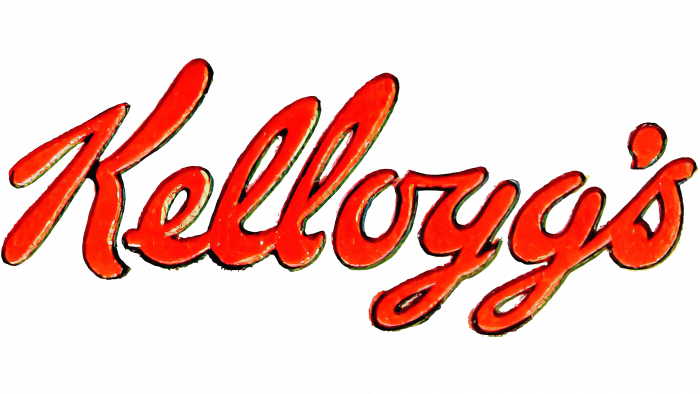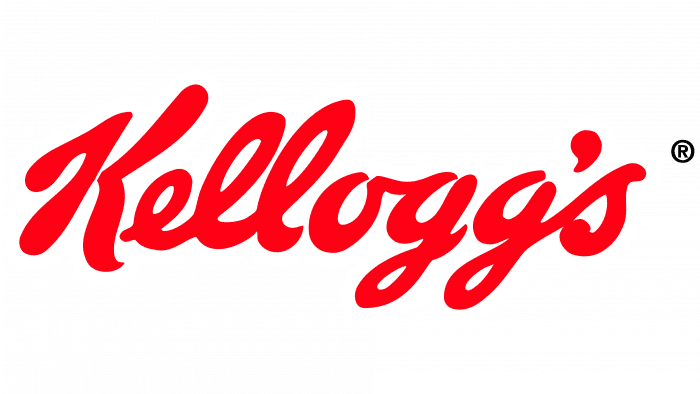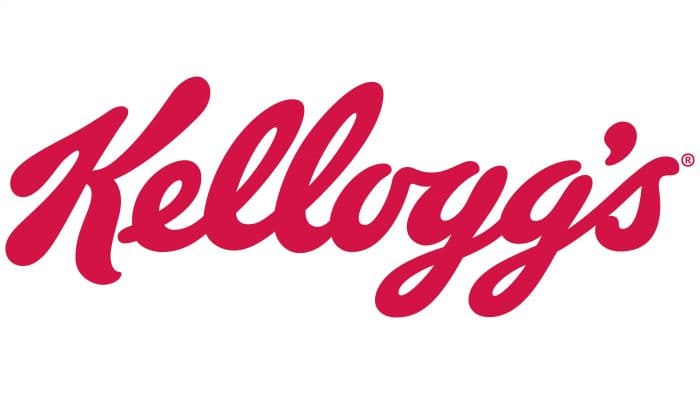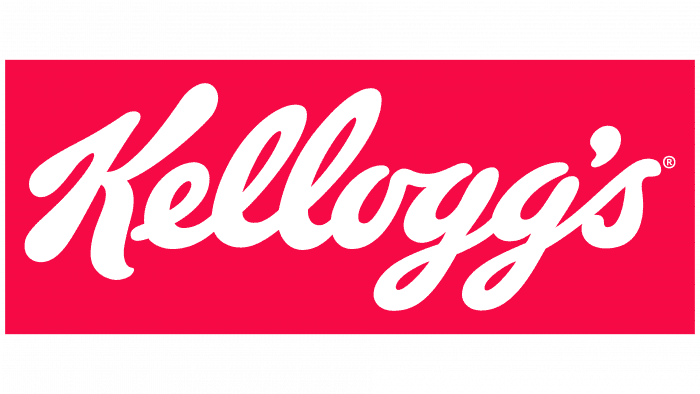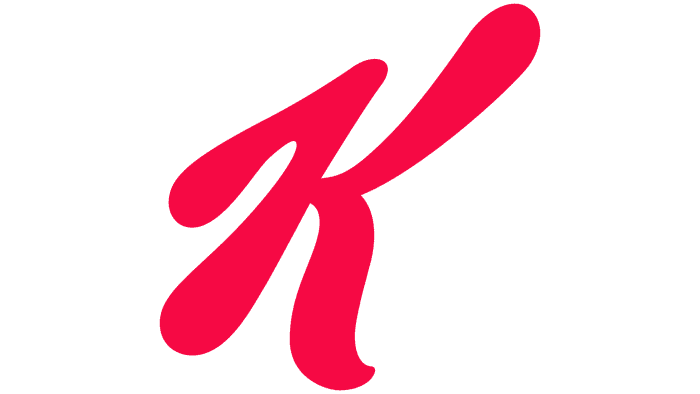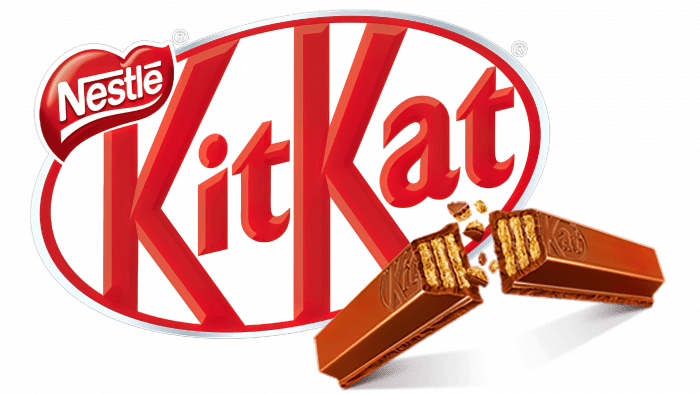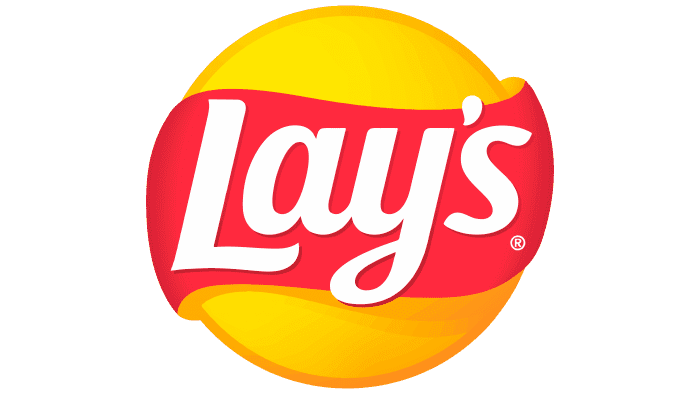The updated Kellogg’s logo is a symbolic reflection of changes in strategy and perspectives. Recognition is ensured by adherence to its history – the stylized personal signature of the founder and direction – with a delicious color palette.
Kelloggs: Brand overview
Kellogg’s is a company that produces cereals, snacks, and quick-preparation products. It appeared in 1906 when brothers Will Keith and John Harvey Kellogg learned to make wheat flakes. The business took off rapidly: the company mastered many directions in the food industry and acquired several dozen brands.
Kellogg’s story begins more than a century ago, in 1894, within the confines of a modest sanatorium in Battle Creek, Michigan. This is where the Kellogg brothers, Will Keith and John Harvey, made an unintended but fortunate discovery that led to the invention of cornflakes. Their invention quickly became popular among their patients, setting the stage for a revolution in breakfast foods. By 1906, this discovery had transformed into the mass production of Kellogg’s Corn Flakes, and the first batch sold out in just a few hours.
The company officially became the Kellogg Company in 1909, embarking on a mission to champion the health benefits of cereals. This era introduced enduring products like All-Bran in 1916 and Rice Krispies in 1928, which weren’t just tasty but were also marketed for their health advantages. Kellogg’s pioneered targeting children with toys in cereal boxes and creating memorable mascots like Snap, Crackle, and Pop in the 1930s.
Through the mid-20th century, Kellogg’s continued to innovate, launching products like Sugar Smacks and Frosted Flakes and venturing beyond breakfast cereals into snacks and crackers. The company’s global expansion was marked by establishing factories in countries like Canada, Australia, and the UK, making its products available in 18 countries by the late 1960s.
The following decades saw Kellogg’s broadening its portfolio through acquisitions, including brands like Keebler and Pringles, and the introduction of Nutri-Grain bars. Responding to a growing demand for healthier eating options in the 2010s, Kellogg’s updated its recipes to reduce sugar, add whole grains, and introduce organic and gluten-free products.
In a strategic move in 2022, Kellogg’s announced its plan to split into three companies focusing on snacks, cereals for North America, and plant-based foods. This decision aims to make Kellogg’s more agile and better suited to adapt to changing market demands.
From its inception in a small Michigan sanatorium to becoming a global food corporation, Kellogg’s has consistently prioritized innovation, effective marketing, and adapting to consumer needs. Today, Kellogg’s products are a staple in over 180 countries, offering a wide range of food items that energize families throughout their day. Even as it evolves, Kellogg’s remains dedicated to delivering delicious, nutritious foods, staying true to the vision established over a hundred years ago.
Meaning and History
Will Keith personally signed each package to distinguish Kellogg’s cornflakes from similar products of other manufacturers. This continued for a whole year. Then, the company owners decided to speed up the process and created a logo with the stylized inscription “Kellogg’s.” According to legal documents, the adopted trademark was first used on May 1, 1907.
In 1916, designers changed the font of the inscription and, in 1955, the color. As a result, the emblem became dark red. In 2012, the company underwent its largest rebranding, entrusting it to the consulting agency Interbrand. Ferris Crane and Andrew Y. Ames, responsible for the brand identity, repainted “Kellogg’s” in pink and added the slogan “Let’s Make Today Great”. This led to the modern version of the classic sign with bright visual graphics.
What is Kellogg’s?
Kellogg’s is the trade name of Kellogg Company. It’s a manufacturer of semi-finished products and snacks, selling products under various brands. Despite the company’s American origin, it holds a royal warrant.
1906 – 1907
The debut version isn’t a logo at all. It’s the personal signature of one of the founding brothers – Will Keith Kellogg, seen on an improvised emblem. It was their first trademark with a personal touch, as the brand owner signed each flake package to distinguish his product from others. This continued for an entire year. The inscription is made with black ink on a light background and looks like a fast, semi-closed cursive.
1907 – 1916
Tired of signing every package of products, the brothers decided to improve the business and created a logo in the form of their signature. In May 1907, they first marked the products they produced. It was also a form of handwriting – cursive, calligraphy, and connected variations. The signs had a slight tilt and an intricate letter “K.”
1916 – 1955
The redesign affected the style of inscriptions: the letters became more elongated, smoother, and less inclined. Each symbol received a black frame, changing the color from regular red to scarlet.
1955 – 2012
In 1955, the logo was repainted in a rich red color. Everything else remained the same.
2012 – today
The modern logo is the result of a large-scale rebranding conducted by Interbrand. The main focus was on color, offering a more relevant option—red and fuchsia pink. No other changes were made, as the stylized signature is a well-recognized brand name among consumers.
Kelloggs: Interesting Facts
Kellogg’s is a big name in breakfast cereals and has an interesting story dating back to 1906. It was started by two brothers, W.K. Kellogg and Dr. John Harvey Kellogg, in Michigan. They wanted to make healthy food for people at Dr. Kellogg’s health place.
- Starting with Brothers: The Kellogg brothers accidentally invented cereal while trying to make a different healthy snack. They made flakes from stale wheat, which turned into Cornflakes.
- All About Health: W.K. Kellogg cared greatly about making good food for you. Before other companies considered doing that, he added vitamins and other stuff to cereals.
- TV Ads: Kellogg’s was one of the first to advertise on TV in the 1950s. It sponsored TV shows and got its cereal in front of many people.
- Famous Characters: They have famous mascots, like Tony the Tiger and Toucan Sam, that many of us know and love. These characters make their cereals fun for kids and adults.
- New Kind of Boxes: Kellogg’s was the first to sell cereal in boxes, as we see today. W.K. Kellogg thought keeping food clean and safe was important, so he developed better packaging.
- Selling Everywhere: Kellogg’s cereals are now available in over 180 countries. They also make various breakfast foods and snacks to suit different tastes.
- Helping Out: The W.K. Kellogg Foundation, started in 1930, helps kids and communities with education and health. It shows Kellogg’s cares about more than just selling food.
- Part of Culture: Kellogg’s isn’t just for breakfast; it’s appeared in movies and TV shows and has famous ads and sayings like “They’re Gr-r-reat!”
Kellogg’s has grown from a small health food idea to a huge company that makes breakfast a lot more fun and nutritious for people worldwide.
Font and Colors
The logo’s concept has never changed. The word “Kellogg’s” imitates Will Keith’s signature, written a hundred years ago. The letters are inclined to the right and connected. Only the capital letter “K” is positioned separately. The lines are smooth and rounded, like typographic laundry cursive. However, the company uses its handwritten font, Kellogg’s Sans, which gives the logo a distinctive character.
FAQ
Is it Kellogg’s or Kellogg’s?
Kellogg’s is a well-known cereal and food company that began in Battle Creek, Michigan. It’s named after Will Keith Kellogg, who was instrumental in popularizing cornflakes and other cereals worldwide. The brand offers a wide range of breakfast cereals to meet various tastes and dietary requirements. Kellogg’s also produces snacks, frozen foods, and vegetarian products, adapting to changing consumer preferences.
Using an apostrophe in “Kellogg’s” signifies that the products belong to Kellogg, adding a personal touch and highlighting the brand’s heritage. Recognizing the potential of their discovery, Will Keith Kellogg founded his own company in 1906, which has evolved into the Kellogg’s we know today. Kellogg’s has become a major international business known for its innovation, quality, and environmental commitment.
Is Kellogg’s a UK brand?
Kellogg’s, known for its cereals and various food products, began its journey in Battle Creek, Michigan. Corn Flakes, one of the brand’s earliest and still beloved breakfast cereals, marked a significant innovation in morning meals, setting the stage for the company’s growth.
Kellogg’s has made a name for itself in the United States, the UK, and other countries by creating products that cater to local tastes. In the UK, Kellogg’s cereals have become a breakfast staple, thanks to the company’s commitment to understanding and meeting British preferences. While enjoyed globally, the brand remains quintessentially American, rooted in Michigan—Kellogg’s aims to offer consumers delicious, quality breakfast options and snacks worldwide.
Why is Kellogg’s splitting into three companies?
Kellogg’s is dividing itself into three companies to improve focus and increase profits. This shift reflects a broader movement in the food industry towards agility and better alignment with consumer preferences.
The first company will manage Kellogg’s cereal operations in North America, focusing on popular cereals like Corn and Frosted Flakes. This specialization aims to cater directly to the tastes and needs of cereal consumers in that region.
The second entity will handle snacks and breakfast foods globally. Given the universal popularity of snacks for both enjoyment and quick meals, this division will work on introducing new breakfast options worldwide, leveraging Kellogg’s established brands to meet current eating trends.
The third segment will dedicate itself to plant-based foods, responding to the growing demand for health-conscious, environmentally friendly, and ethically produced options. This company will concentrate on developing and marketing such products.
This strategic separation will enable each Kellogg’s branch to thrive independently. This reorganization is expected to enhance their market relevance and profitability.
What did Kellogg invent?
John Harvey Kellogg is well known for creating cornflakes, but his contributions go beyond that. He was passionate about producing nutritious food. He was associated with the Battle Creek Sanitarium in Michigan, a center dedicated to health. He and his brother, Will Keith Kellogg, accidentally invented cornflakes while attempting to create a new bread type. This experiment led to the discovery of a method to produce flakes from corn.
Kellogg’s innovations didn’t end with cornflakes. He also developed peanut butter to offer vegetarians a reliable, digestible protein source. Additionally, he created granose biscuits, a wholesome snack that gained popularity in Australia and England.
Is Kellogg’s good for health?
Kellogg’s cereals offer health benefits because they are low in calories, making them a good choice for weight management. They enrich their cereals with essential nutrients, including B vitamins for energy and iron for healthy blood, supporting overall well-being.
These cereals are typically low in fat and cholesterol-free, which benefits heart health. When combined with other nutritious foods, they effectively complement a health-conscious diet.
Eating Kellogg’s cereals can improve your health thanks to the nutrients they contain. B vitamins are crucial for converting food into energy and maintaining a healthy nervous system, while iron is vital for oxygen transport. It’s important to note that not all Kellogg’s cereals are created equal. Some contain high levels of added sugar, which can negatively impact your health, including risks of weight gain and diabetes. Choosing cereals high in fiber and low in added sugar is advisable. Enhancing your cereal with fruits, nuts, or low-fat milk can boost its nutritional value.
Who designed the Kellogg’s logo?
The Kellogg’s recognized logo began with a unique touch based on founder Will Keith Kellogg’s signature. This signature on the logo was more than a design; it was Kellogg’s promise of quality behind his products.
As Kellogg’s expanded, the logo evolved. Interbrand, a company specializing in branding, updated the logo to keep Will’s signature while giving it a modern look. This update helped the logo stay relevant in today’s market and made it recognizable globally.
Where did the Kellogg’s logo come from?
The Kellogg’s logo started uniquely with its founder, Will Keith Kellogg. Initially, Will wanted his cereals to stand out and avoid copies. He came up with a creative idea: signing each cereal box himself. This signature was a pledge of quality, telling customers they were getting real, top-quality Kellogg’s products.
This approach was new at the time and helped build trust with customers. The signature on the boxes meant quality and authenticity. As Kellogg’s grew in popularity, Will’s signature became the official logo we know today. This change kept the logo as a symbol of quality but made it suitable for a global audience.
What does the Kellogg’s logo represent?
The Kellogg’s logo might look simple with its red, handwritten style but carries a significant meaning. The logo is based on the signature of the company’s founder, Will Keith Kellogg, which adds a personal touch to every product.
The logo’s eye-catching red color symbolizes the company’s dedication to producing high-quality food. It also helps Kellogg’s products stand out on store shelves and conveys a sense of warmth and family-friendly values. The handwritten aspect of the logo emphasizes tradition and quality, setting Kellogg’s apart from more modern but impersonal brands.
Why is the Kellogg’s logo red?
The Kellogg’s logo is famously red, a choice that’s not only eye-catching but also full of meaning for the company. This red has adorned Kellogg’s branding since 1907, and while the exact shade has slightly varied over time, the commitment to red has remained constant.
Red symbolizes energy, passion, and action, which aligns with Kellogg’s mission to offer energizing breakfast options. It’s a strategic color that helps Kellogg’s products stand out on store shelves, an essential factor for market competition. The consistent use of red in the logo makes Kellogg’s products easily identifiable.
What does the Kellogg’s logo symbolize?
The Kellogg’s logo is more than a simple company symbol. It began with the Kellogg brothers, particularly Will Keith Kellogg, who signed each cereal box to guarantee its authenticity. This practice was not solely for brand protection; it aimed to assure customers they were purchasing a high-quality product.
As Kellogg’s expanded, Will Keith Kellogg’s signature on the boxes evolved into the company’s official logo, seen on all Kellogg products today. Although the logo became globally recognized, its significance remained the same. It symbolizes the company’s enduring dedication to delivering the finest products. The logo is Kellogg’s way of ensuring customers always receive real, trustworthy products.
What does the Kellogg’s logo mean?
The Kellogg’s logo is significant. It represents a promise from the company’s founder to deliver authentic and high-quality cereal. The logo features the founder’s signature, emphasizing the authenticity and quality of every Kellogg’s cereal box. This practice was initiated to assure customers that the cereal they bought was genuine.
The founder’s signature on the logo serves as a pledge of quality from Kellogg’s to its customers, showing the company’s dedication to producing truly good products. It establishes trust by highlighting the company’s commitment to honesty and quality.
Why is there a chicken in Kellogg’s package?
Since 1957, Kellogg’s cornflake packages have featured a rooster, thanks to a clever idea from Nancy Richards, a friend of Kellogg’s. She suggested the rooster because the name “Kellogg’s” sounds like the Welsh word for rooster, “ceiliog,” and roosters are commonly found on farms, where corn, the main ingredient of cornflakes, is grown. This made the rooster an ideal mascot for the cereal.
The rooster, named Cornelius “Corny” Rooster, symbolizes Kellogg’s cornflakes’ natural and wholesome qualities. Although Cornelius is not on the official Kellogg’s logo, he plays a significant role in the brand’s packaging. His vibrant appearance and connection to corn help Kellogg’s cornflakes catch customers’ eyes.
What is Kellogg’s slogan?
Kellogg’s slogan, “Let’s Make Today Great,” encourages people to aim high daily. It implies that eating Kellogg’s for breakfast can be a great start to a successful day. This slogan is a part of their message that a good morning routine includes their products.
They also have another slogan from their mascot, Cornelius: “Corny,” the rooster: “Wake up, wake up, wake up to Kellogg’s Corn Flakes!” Though not on their logo, it supports the main slogan by emphasizing a good start to the day. Cornelius’s phrase is easy to remember because of how it’s repeated, and his happy look makes Kellogg’s seem welcoming. Both slogans work together to say that Kellogg’s offers more than food.
Why is the company called Kellogg?
“Kellogg’s” comes from its founders, Will Keith and John Harvey Kellogg. They were committed to making quality and authentic products. Will Keith Kellogg sign each cereal box to guarantee its quality. This signature meant that anything with the Kellogg name was top-notch.
As Kellogg’s grew and signing each box by hand became impossible, they started printing Will’s signature on the boxes. This change helped the brand keep its promise of quality while reaching more customers. The signature on Kellogg’s products reminds us of the brand’s history and commitment to excellence.
